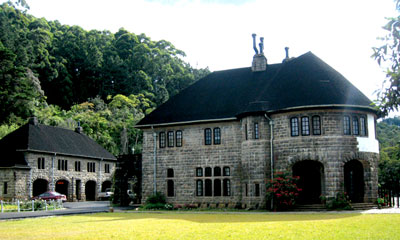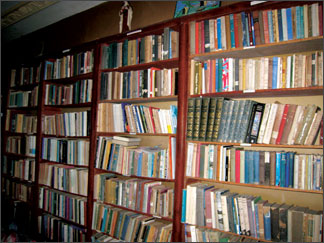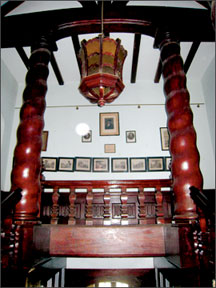Priceless antiquity
Adisham Bungalow
By Rosanne KOELMEYER ANDERSON
[email protected]
|

Front view of Adisham Bungalow
|
Antiquity is the most treasured gift of all generations and Sri
Lanka’s illustrious sites of antiquity have undoubtedly spurred the
hearts of many a visitor, time immemorial. One such location, up in the
hills, amidst the enthralling scenic splendour and the footprints of old
English lifestyle; is the conspicuous, aged old prestigious Adisham
Bungalow built by Sir Thomas Lester Willis.
Apparently, this intrepid seventeen- year-old Englishman who decided
to run away from home and come to Sri Lanka in 1887 via a ship that
brought tea to Sri Lanka with, just 10 sterling pounds in hand seemed to
be mesmerized by the isle’s enchanting beauty so much so that he built
and left behind a priceless treasure of typical British antiquity, the
Adisham Bungalow.
Named after the village of Adisham from which the young man came
from, the foundation stone for the bungalow which comprises forty rooms
was layed in 1927 and completed in 1931. What is unique is the precision
with which the bungalow was constructed: the cut stones needed to build
the treasure were shipped from England and so were the engineers. The
technicians were brought down from North India and so was the Burma Teak
used for the roofing, staircase and the four oak trunks which adds a
streak of strange allure to its antiquity: its staircase being
distinctively alike that of the staircase at Buckingham Palace, England.
So are the priceless beautiful Persian carpets which are said to be
more than 200-years-old. The special wall paper covering the inside of
the building is shimmering and exceptionally intriguing; it could be
washed with water while the sofas are covered with Camel skin. The
priceless furniture is of different shapes, designs and carvings and are
simply awesome. On the upper floor of the bungalow, houses the library
which speaks volumes: some of the books contained span over 500 years as
well as the visitors room.
Moreover, the painting of Sir Willis by the famous British painter
David Painter is an equally unique treasure similar to that of Mona Lisa
by Leonardo Da Vinci. Amazingly not only the eyes in the painting move
but the entire body too at which ever direction you place yourself in.
Apparently, there are sixteen priceless paintings displayed at the
Adisham Bungalow: the lithography’s of which are at the British Museum.
However, considering the isolated area upon which this prestigious
bungalow has been built, which takes you through a narrow uneven road
barely enough to take a car to its entrance is similar to that of any
private road to an estate bungalow. It is inconceivable as to how these
huge oak trumps and building material would have been transported at a
time when there is said to have been only one railway. Although now
antiquity, Sir Willis has had no easy task to accomplish his dream :
“Nothing is after all denied to well “directed labour, and nothing is
ever to be attained without it.”

Adisham Stores |

The Library |

Wooden pillars at the top of the staircase |

A red carpet placed along the steps at the main private entrance
|
Having set foot on the shores of Sri Lanka he is said to have toiled
for several years at the Dick Oya Tea Industry. Having collected a
sufficient amount of money, Thomas Lester Willis is said to have come to
Haputale and joined the Glennore Tea Industry and even held the post of
Governor of the Hill Country till 1948. It is also configured that he
had worked as a Senior partner for George Steuarts tea industry from
1928-1948 after which he was honoured with Kingship by her Majesty Queen
Elizabeth and was addressed as Sir Thomas Lester Willis.
And as the story goes, “There is a divinity that shapes our ends,
rough- hew them as we will,” it was for Sir Willis a father of two. His
children died in World War 11 in Germany in 1937 and most instinctively
Lady Evelyn Willis was devastated leaving her seriously ill. She
subsequently passed away in Bombay while being taken to England for
treatment. Sir Willis had to leave Sri Lanka in 1951 after Sri Lanka’s
gained Independence.
He had then sold his properties to the directress of Sedawatte
Company, the late Mrs. Wimal Wijewardena who was also the then Minister
of Health who owned this prestigious bungalow from 1951-1960. It was in
1960 that the Adisham Bungalow and the 12 acres of land that belonged to
it was sold once again. Now owned by the Catholic Church and used as a
centre to teach religion to priests of the Benedictine Order, it is
maintained as a Benedictine Monastery.
The monastery is maintained with the sale of the food products
manufactured at this centre, Adisham Stores which is a building that was
used formerly as a stable and drivers quarters.The water system here is
unique too. Interestingly the water which is pumped from the hill side
is sent through pipes from the boiler room even to the upper floors of
the bungalow without the use of a single motor. Another unique feature
is the wind turbines fixed on the roof by which the cold wind is sent
through down to the fire places which amazingly heats up a whole room.
Everything practically is unique at Adisham Bungalow and its worth a
trip, for its priceless antiquity.
Pix Rosanne Koelmeyer Anderson
|
